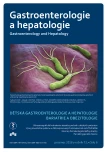Endoscopy ligation by the „loop and let go“ technique as a treatment of rectal syndrome caused by a rectal lipoma
Authors:
Baťková B. 1; Maceček J. 1; Staňka B. 1; Stašek M. 2; Černoch J. 1
Authors‘ workplace:
Gastroenterologické oddělení, Nemocnice Prostějov, Středomoravská nemocniční, a. s.
1; I. chirurgická klinika LF UP a FN Olomouc
2
Published in:
Gastroent Hepatol 2018; 72(6): 534-537
Category:
doi:
https://doi.org/10.14735/amgh2018534
Overview
Rectal syndrome is a condition characterized by frequent compulsive or painful defecation and is often associated with a small amount of blood in stool or mucus. Symptoms usually appear slowly, depending on the cause of the problem. It often takes weeks to months for the patient to seek medical attention. Differential diagnosis of rectal syndrome encompasses both functional disorders and morphologically defined conditions including a wide range of anorectal dysfunctions. Diagnosis is often a multidisciplinary and an impotent role is played by endoscopic methods. This case report describes a case of rectal syndrome caused by a lipoma in the anorectal area, which was diagnosed by colonoscopy and treated by the „loop and let go“ ligation technique. A scar after ligation of the lipoma was observed at 6 weeks and the patient‘s symptoms completely disappeared. Rectal lipoma is less common in structural pathology, which may be the cause of rectal syndrome, even if the lesion is relatively small. Endoscopic therapy is a safe, less burdensome first therapeutical choice, and has the advantage of outpatient treatment with minimal adverse events. The alternative to endoscopic treatment of unsolvable lesions is surgery.
Key words:
anorectal dysfunction – rectal syndrome – lipoma
Submitted: 11. 9. 2018
Accepted: 10. 10. 2018
Sources
1. Horák L, Skřička T, Šlauf P et al. Praktická proktologie. Praha: Grada Publishing 2013.
2. Prokešová J, Dolina J. Anorektální dysfunkce. Interní medicína pro praxi 2009; 11(5): 218– 220.
3. Gerjy R, Lindhoff-Larson A, Nyström PO. Grade od prolapse and symptoms of haemorrhoids are poorly correlated: results of a classification algorithm in 270 patients. Colorectal Disease 2008; 10(7): 694– 700. doi: 10.1111/ j.1463-1318.2008.01498.x.
4. Mansoor S, Dolkar T, El-Fanek H. Polyps and polypoid lesions of the colon. Int J Surg Pathol 2013; 21(3): 215– 223. doi: 10.1177/ 1066 896913481060.
5. Zavoral M, Vojtěchová G, Suchánek Š. Klasifikace kolorektálního karcinomu. Onkologie 2013; 7(4): 172– 175.
6. Hayashi N, Tanaka S, Hewett DG et al. Endoscopic prediction of deep submucosal invasive carcinoma: validation of the narrow-band imaging international colorectal endoscopic (NICE) classification. Gastrointest Endosc 2013; 78(4): 625– 632. doi: 10.1016/ j.gie.2013.04.185.
7. Falt P, Urban O, Vítek P et al. Koloskopie. Praha: Grada Publishing 2015.
8. Urban O, Falt P, Fojtík P et al. Comparison of endoscopic mucosal resection and endoscopic submucosal dissection in the treatment of flat neoplastic lesions in the rectum. Gastroent Hepatol 2018; 72(3): 193– 198. doi: 10.14735/ amgh2018193.
9. Marshall GB, Dunham C, Wiemer C et al. Answer to case of the month 132. Adult ileocolic intussusception secondary to a submucosal lipoma. Can Assoc Radiol J 2008; 59(2): 89– 91.
10. Gabalec L, Adámková S, Nedvěd K et al. Intususcepce způsobená lipomem tlustého střeva. Folia Gastroenterol Hepatol 2009; 7(2), 74– 76.
11. Pfeil SA, Weaver MG, Abdul-Karim FW et al. Colonic lipomas: outcome of endoscopic removal. Gastrointest Endosc 1990; 36(5): 435– 438. doi: 10.1159/ 000260053.
12. Hwang JH, Saunders MD, Rulyak SJ et al. A prospective study comparing endoscopy and EUS in the evaluation of GI subepithelial masses. Gastrointest Endosc 2005; 62(2): 202– 208.
13. Ivekovic H, Rustemovic N, Brkic T et al. Endoscopic ligation (“Loop-And-Let-Go”) is effective treatment for large colonic lipomas: a prospective validation study. BMC Gastroenterol 2014; 14: 122. doi: 10.1186/ 1471-230X-14-122.
14. Kopáčová M, Rejchrt S, Bureš J. Unroofing technique as an option for the endoscopic treatment of giant gastrointestinal lipomas. Acta Med 2015; 58(4): 115– 118. doi: 10.14712/ 18059694.2016.1.
Labels
Paediatric gastroenterology Gastroenterology and hepatology SurgeryArticle was published in
Gastroenterology and Hepatology

2018 Issue 6
- Metamizole vs. Tramadol in Postoperative Analgesia
- Metamizole at a Glance and in Practice – Effective Non-Opioid Analgesic for All Ages
- Possibilities of Using Metamizole in the Treatment of Acute Primary Headaches
- Current Insights into the Antispasmodic and Analgesic Effects of Metamizole on the Gastrointestinal Tract
- Spasmolytic Effect of Metamizole
Most read in this issue
- Meckel’s diverticulum as a cause of abdominal emergency
- Hepatopathy as the first manifestation of systemic AL amyloidosis
- Wilson’s disease in childhood – two case reports
- News of pharmacological treatment of obesity
